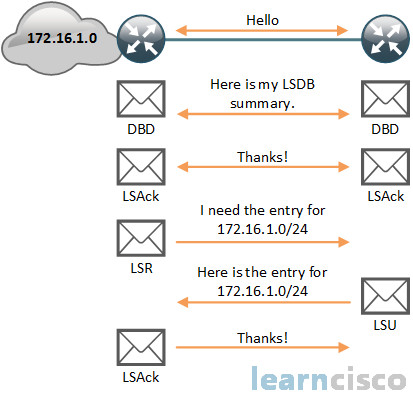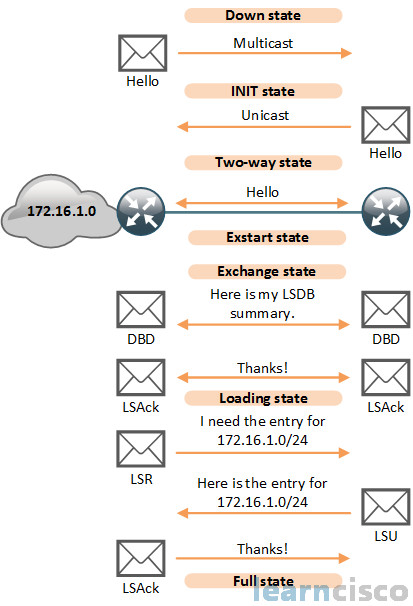This is the convergent process that we’re looking at right now. We’re also going to see the neighborship formation process. Тhis is in fact a subset of. But let’s say we’ve got some information dealt between two routers. One rather has more information than another. We got to get that information across to the other side, synchronize those routers databases, if you will. This would be the process.

First, we would have had to do some of the initial steps of neighborship formation, we do that with hellos. Then we send a database descriptor packet, DBD, okay that acronym is right here on this page. That’s our Type 2 Open Shortest Path First, or OSPF, packet type. And that lists off all the things we don’t know about. How do I ask for those things? Oh! And by the way, it’s acknowledged, you can see that. But how do we ask for those things that we glean from the DBD that we don’t have yet?
We send out our link-state request and you can see here that it’s asking for a specific entry. It’s not asking for everything. No just what it needs. In this case, it needs a specific entry for the 172.16.1.0/24. The router that receives that link-state request has to send a link-state update back. Oh, here is the information I have for that network you’re looking for. And notice at the bottom, we’re polite, we say thanks. We send that link-state acknowledgment back, so that way there they know we receive that particular entry we had asked for.
OSPF Neighbor States
In the world of examinations, there are some bullets that you have to bite in terms of memorization. Make sure that you’re in the clear on this important memorization that you see here. And here are the states.

We have, in fact, seen two of these states before, the Two-way state and the Full state. We didn’t see it, but we were talking about it. So I want you to be able to rattle off those states in your head. Can I do it myself? I’m going to do it:
- Down
- Init
- Two-way
- Exstart
- Exchange
- Loading
- Full
Let’s talk to you about what this really means. Down, OSPF is not running. Init, we have started to communicate, so an OSPF network statement enabled us to work on that link, we are in Init. We won’t really see anything saying Init explicitly inside of the operating system of the router. But then we get to the Two-way state. Here’s the deal with the Two-way state. We have found extraterrestrial intelligence or extra router intelligence. Think about the search for extraterrestrial intelligence, or SETI, program. When we are looking out there in space with our big radio telescopes, what are we looking for? Well one of the most amazing things would be to see ourselves being beamed back like our television shows. They know about us, they’re broadcasting that. Well the Two-way state is the same thing. The Two-way state says, I can see my own IP address being bounced off from someone else. They know I’m there, they know I’m there because they can see me. They’ve included my address, okay. Now I want you to remember that the DR others stay in the state. They don’t try to go beyond it. We only try to go beyond it when we are talking to the designated routers, okay. So that’s when we get to Exstart, Exchange, Loading, Full.
The Exstart is a tug of war. What happens here is, we have two routers and say, “Hey, I want to talk first” and one of them gets to talk first. And it’s the router with the highest router ID, not like it matters. Then Exchange. As we’re doing those DBDs to set the stage on details that we’ll need to learn about, the database descriptor packets, saying here are all the sequences. So that was Exchange. We’re not really exchanging routing information there. We’re getting the high-level points.
Loading is when we are exchanging routing information. The Loading state is where we back the truck up and we go. I want that information I asked for it within link-state request, or LSR. I get an link-state update, or LSU, in return. There are some acknowledgments yeah, yeah, yeah. And then eventually, once we’ve asked and got an answer to every single sequence number that we learned about with the DBD, then we are converged. We are at the Full state. Now the details, I don’t need you to know about them in terms of being able to walk someone through to that degree. But you better remember the order. You better remember the order. So can you do it? Close your eyes. Down, Init, Two-way, Exstart, Exchange, Loading, Full. I don’t want to ask you to do something that I can’t do myself. But if you know that then you should be in the clear for this discussion on neighbor states.
Our Recommended Premium CCNA Training Resources
These are the best CCNA training resources online:
Click Here to get the Cisco CCNA Gold Bootcamp, the most comprehensive and highest rated CCNA course online with a 4.8 star rating from over 30,000 public reviews. I recommend this as your primary study source to learn all the topics on the exam.

Want to take your practice tests to the next level? AlphaPreps purpose-built Cisco test engine has the largest question bank, adaptive questions, and advanced reporting which tells you exactly when you are ready to pass the real exam. Click here for your free trial.
